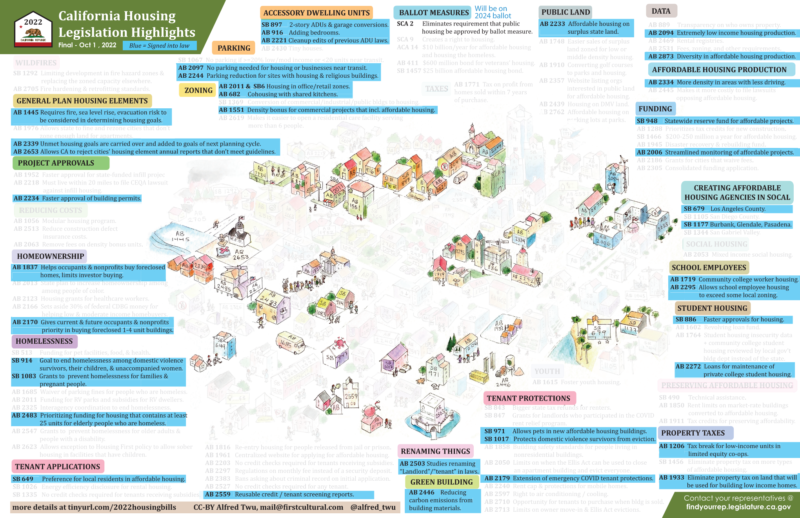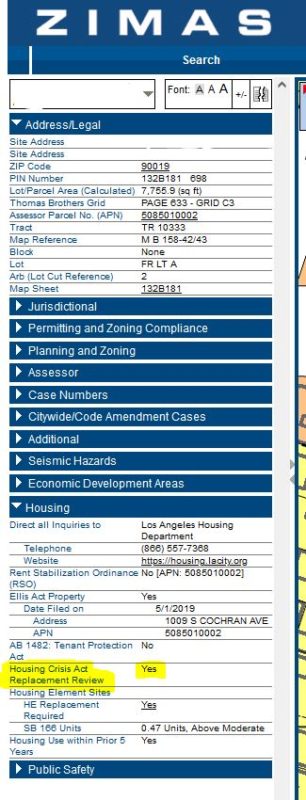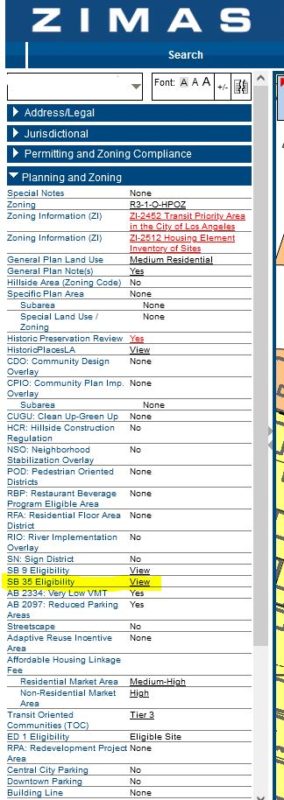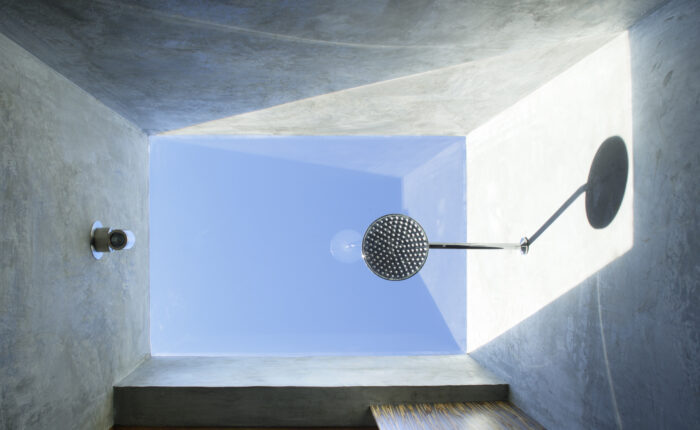I don’t know about you, but every time I read a sentence containing the abbreviations “SB” or “AB” my brain immediately hurts trying to figure out which state senate or assembly bill is being referenced. The research for this blog found me in an avalanche of state bills that all started to intertwine. How is anyone supposed to navigate this?!
The state has been working hard to address the housing shortage. Last year alone, 104 housing related bills were introduced and nearly 40 became effective. For a quick look at the 155 new housing bills introduced in 2023 (no, I’m not joking), check out the new list of proposed bills here.

Lucky for you, it’s literally our job to help navigate this Charlotte’s web so we’ve looked through all the relevant bills and city documents and highlighted the major points below. Best yet, we’ve tried to link to the various applications and websites and get you to the right places, or at the very least within a one-mile radius of where you need to be.
Our previous blogs in this Affordable Housing series took a peek at the history of how we got to the current shortage. If you haven’t already, check out Part 1 and Part 2 to get up to speed. These next two blogs will look at current housing efforts and what they mean for architects, developers and residents.
This first set of selected bills we’re looking at are all “streamline”-focused in an effort to minimize obstacles and timeline hiccups for affordable housing projects.
SB330 / SB8 – The Housing Crisis Act of 2019 (HCA)
SB330 Effective January 1, 2020, and then amended/”clarified” by SB8 Effective January 1, 2022
Summary
This law covers a multitude of different permitting aspects in an effort to streamline and protect affordable housing throughout the city. It also deems a statewide housing emergency until January 1, 2025, but has since been extended by SB8 until 2030.
There are 14 main highlights of the updated SB8 Bill:
- Prohibits projects with a net loss of housing units (e., if there are 3 units existing, your new project must have 3 or more units proposed)
- Requires any “protected units” be replaced in-kind (price/# bedrooms)
- Creates new tenant protections (can stay up to 6 months prior to construction, relocation assistance, first right of refusal/right to return)
- Creates a new vesting process to lock in ordinances/policies at time of application
- Requires that historic status must be determined up front
- Limits number of public hearings allowed
- Shortens permit review timeframes for some projects
- Prohibits imposing non-objective design review standards
- Limits the city’s ability to downzone a lot
What is the difference in the newer SB8?
- Extend rights to projects submitted before 2030
- Clarifies that some of the HCA provisions apply to projects without discretionary approvals (including by-right and ministerial projects)
- Clarifies that some of these guidelines apply to single unit developments
What projects does this apply to?
- Nearly all residential projects outside a Very High Fire Hazard Severity Zone (VHFHSZ)
- Mixed use with at least two-thirds residential
- Transitional or supportive housing projects
Residential projects with only alterations or those with no increase/decrease of residential units are not HCA “projects”.
What does it mean for my project?
The proposed housing project must provide at least as many dwelling units as has existed in the past 5 years. It must ALSO replace all existing/demolished “Protected Units”, such as:
- Affordable units (subject to recorded covenant, ordinance or law to restrict rent to lower or very low income)
- Rent-protected units
- Occupied by lower or very low income households (an affordable Protected Unit)
- Units withdrawn from rent/lease by the Ellis act within the last 10 years
 If the project has units subject to the Rent Stabilization Ordinance (RSO) or Moderate Income level tenants, the city can require either: (1) replacement units be affordable for low income households for 55 years via recorded covenant, or (2) require units be replaced with RSO units. Current tenants being displaced have the right to remain in their units until six months before start of construction with proper notice. Lower Income Household occupants are ALSO entitled to: (1) relocation benefits, and (2) right of first refusal/”Right to Return” for a comparable unit in the new development at an “affordable rent”. This does NOT apply to single family dwellings and housing developments containing 100% low income units.
If the project has units subject to the Rent Stabilization Ordinance (RSO) or Moderate Income level tenants, the city can require either: (1) replacement units be affordable for low income households for 55 years via recorded covenant, or (2) require units be replaced with RSO units. Current tenants being displaced have the right to remain in their units until six months before start of construction with proper notice. Lower Income Household occupants are ALSO entitled to: (1) relocation benefits, and (2) right of first refusal/”Right to Return” for a comparable unit in the new development at an “affordable rent”. This does NOT apply to single family dwellings and housing developments containing 100% low income units.
Where do we even start?
- To double check if all of this applies to your lot, you can now see this under the “Housing” Tab on ZIMAS.
- Check out the city’s project matrix to see which elements apply based on the project type.
- Obtain a Replacement Unit Determination (RUD) letter before submitting an application to city planning. If your project does not require a city planning application, this will be obtained from the Housing Department during the clearance process prior to permits.
- There is an alternate declaration available to confirm there is “no net loss of units”
- This has a fee of $1027 per unit, dwelling, or vacant property
- There is a new optional preliminary application that also allows discretionary housing projects to “lock-in” current ordinances and policies.
- Fill out and submit Preliminary Zoning Assessment (PZA) to LADBS.
- This has a fee of 1/3 of building plan check cost (note: could be several thousand dollars per unit)
- NOTE: this DOES NOT currently lock in building ordinances, so any new codes/ordinances introduced during this time must be accommodated once the remaining plan check review begins
- Once the RUD letter and PZA are completed, submit a planning application

SB35 – Streamlined Affordable Housing
Effective January 1, 2018
Summary
This law is an expansion of the previously approved SB35, allowing supportive housing as by-right in areas where multifamily and mixed-use development is permitted. In addition, SB35 has a goal to streamline projects that include supportive housing by making them a “ministerial process” by removing CEQA reviews and all other discretionary approvals previously necessary.
City of Los Angeles has created a new administrative procedure to process these housing projects, called “Streamline Infill Projects” (SIP) to guide the projects through the objective zoning standards (i.e., those that do not involve any subjective judgement). Determinations from the city shall also be expedited, with a response within 60 days (or 90 days for projects with more than 150 units).
What projects does this apply to?
A qualifying project must meet these requirements:
- At least 50% of units must be affordable at 80% Area Median Income or lower and must be restricted
- Multi-family housing (for rent or sale)
- At least two-thirds of the development are residential
- Must comply with the objective zoning standards (i.e., yards, height, lot coverage, etc.)
- Must meet these land use requirements:
- Must be “infill” development
- Zoned for residential use or residential mixed-use
- Cannot be within a coastal zone, farmland, wetland, or Very High Fire Hazard Severity Zone, hazardous waste site, earthquake fault zone, flood area, habitat for protected species, etc.
- Demolition is not required of affordable housing, rent control housing, or housing that has been occupied within the last 10 years
- Demolition of historic structure is not required
- The project must utilize prevailing wage workers, as well as skilled and trained workforce if 50+ units
- Projects also wanting to use the State Density Bonus program are eligible as long as all other requirements are met
 What does it mean for my project?
What does it mean for my project?
Although a planning case filing is required, these highlights should help your project get to the finish line:
- The project will be reviewed through a ministerial process (i.e., no hearing, no appeals, etc.)
- No CEQA review required
- The city has to review/approve projects within 90 days of application (or 180 days if 151+ housing units)
- No parking required if any of these apply (and if not, only 1 space/unit):
- Within one-half mile of public transit
- Located within architectural/historic district
- If on-street parking permits are required
- If car share vehicles are within a block of the development
- The city must issue a Notice of Intent (NOI) to California Native American Tribes to ensure the site is not a tribal or cultural resource
Where do we even start?
- To double check if all of this applies to your lot, you can now see this under the “Planning and Zoning” Tab on ZIMAS. If you click “view” you will see checklists to evaluate the various SB35 criteria.
- On the checklist, confirm the site does not contain any habitat
- If no, then fill out the owner declaration. If review is needed, submit a biologist’s statement.
- SB35 is not possible on sites considered a habitat for protected species
- Request an appointment with the Affordable Housing Services Section (AHSS).
- Fill out and submit a Preliminary Zoning Assessment (PZA) to LADBS.
- Obtain a Replacement Unit Determination (RUD) letter before submitting an application to city planning. If your project does not require a city planning application, the RUD will be obtained from the Housing Department during the clearance process prior to permits.
- There is an alternate declaration available to confirm there is “no net loss of units”
- This has a fee of $1027 per unit, dwelling, or vacant property
- Obtain a referral form (Affordable Housing, TOC, or Supportive Housing)
- Submit the referral form to the Affordable Housing Services Section (AHSS) along with a set of plans, Habitat Form, and pay pre-application review fees
- Once eligibility is confirmed, submit an AB168 Notice of Intent (NOI)
- Once all of this is done, you can file the main entitlement application to City Planning, and then eventually, start the plan check process through LADBS
Doesn’t sound so streamlined, does it?
AB2162 – Streamlining Approval of Supportive Housing
Effective January 1, 2019
Summary
This law aimed to expand the previously approved SB35, allowing supportive housing as by-right in areas where multifamily and mixed-use development is permitted. In addition, it has a goal to streamline projects that include supportive housing by making approval a “ministerial process” by removing CEQA reviews and all other discretionary approvals previously necessary.
City of Los Angeles has created a new administrative procedure to process these housing projects, called “Streamline Infill Projects” (SIP) to guide the projects through the objective zoning standards (i.e., those that do not involve any subjective judgement). Determinations from the city shall also be expedited, with a response within 60 days (or 90 days for projects with more than 150 units).
What is the difference between AB2162 and SB35?
- This new law AB2162 would simplify and expedite approvals even more
- SB35 is limited to certain areas (see the SB35 section), so this new bill expands the right throughout the State
- SB35 excludes projects undergoing rehabilitation of existing units or projects that require demolition of units occupied within the last 10 years, so AB 2162 now includes those.
What projects does this apply to?
- 100% affordable projects, with at least 25% or 12 (whichever is lower) of units deemed “supportive housing”
- This CAN apply to density bonus projects with the above minimum supportive housing units
What does it mean for my project?
Qualifying projects will now be processed through City Planning as a ministerial review with Director of Planning as the final decision maker, issuing a letter of decision deeming the case consistent with development standards and state law criteria. No public hearings will be required, and thus, no appeal processes.
AB168 – Notice of Intent
Effective September 25, 2020
Summary
This bill created a process to allow for tribal consultation before SB35 projects can be accepted for review. This closes a loophole that was created by SB35 streamlining process in removing CEQA review. Within 30 days of receiving an application, the city must provide formal notice for each Tribe associated with the area of the project site. Each tribe has 30 days to accept an invitation for consultation, and if accepted, the city must initiate a consultation within 30 days.
Conclusion
The efforts to promote affordable housing and attempted “streamlining” are well intentioned, but navigating the endless numbers of applications and submittals before even submitting an official planning application is a nightmare. These extra regulations (some in the name of “streamlining”) add months and months of submittals and paperwork before any housing projects can even get submitted. Is this really what we, as voters, wanted?
Keep an eye out for the next blog in the series which will focus on some major Density-Based Bills.
Tracy A. Stone Architect has experience with a variety of affordable housing projects and can provide a feasibility study to evaluate the best development options and state/assembly bills that may apply to your lot(s). Contact us here for more information.
Be sure to check out some of our previous blogs on housing in Los Angeles:
- Why is Housing in Los Angeles So Expensive? (Part 1)
- Why is Housing in Los Angeles So Expensive? (Part 2)
- Senate Bill SB9 – What does it mean for your single-family neighborhood?



